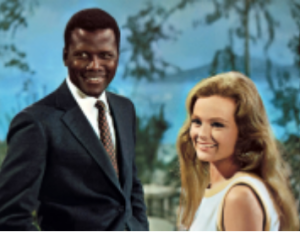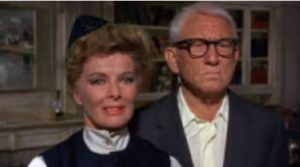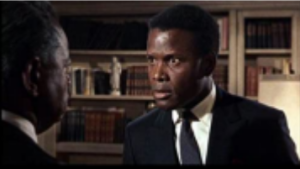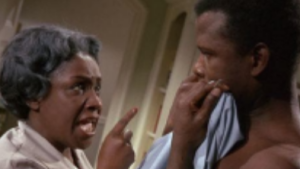6 Guess Who’s Coming to Dinner (1967)
Bias and Discrimination in Guess Who’s Coming to Dinner (1967)
by Byron Drenning
Starring Sidney Poitier and Katherine Hepburn, and being Spencer Tracy’s last film, 1967’s Guess Who’s Coming to Dinner was certain to bring in viewers with its star-heavy cast. The plot of the film is that a woman named Joey returns to her parents’ home from vacation with a man she intends to marry soon. This man is John, who we learn is basically the perfect person a parent could ever want their child to marry, except that Joey is white, and John is black. The following conflict of the film is Joey’s, and later John’s parents struggling with their own bias, having been given a deadline of a single day to give the couple their blessings. The main focus of this struggle is Joey’s father Matt Drayton, who for decades has been an outspoken civil rights advocate and runs a large newspaper that is left-leaning and equal rights in nature, and is now confronted with his own racial bias as he resists his daughter marrying a black man. And that is why I chose this film, as it promises to tackle much more subtle and covert values of race discrimination, as opposed to the overt.

To better understand the film and the ideas within, it’s important to understand when the film was written and released. Guess Who’s Coming to Dinner was released in theaters just five months before The Reverend Martin Luther King Jr, was assassinated. This film was released during an important time for civil rights in America. Most important when it comes to understanding this film is understanding the Supreme Court case of Loving v. Virginia. To greatly simplify it for the purposes of this paper and the film, this was the Supreme Court case in 1967 where the ruling would make interracial marriage legal in all of the U.S. You’ll notice that is the same year that Guess Who’s Coming to Dinner was released. The ruling was made just six months before the film would release, and was a direct inspiration for the film, even before the verdict was made. But arguably most important to really grasp the film is to know that even though interracial marriage was legal, doesn’t mean it was accepted or safe. To quote Sarah Dunne, “In 1968, one year after the Loving v. Virginia verdict, and the release of Guess Who’s Coming to Dinner, only ‘20% of Americans approved of marriage between blacks and whites.’”. This is arguably the most important thing to keep in mind when watching and dissecting this film.
To better dissect the themes of Difference, Power, and Discrimination present in this film, we will be focusing on the characters in the film. Namely, their portrayals and characterization, and whether or not they do a good job at accurately and respectfully representing the topic. In particular, we will focus on four characters; Matt Drayton, Joey Drayton, John Prentice, and Tillie, who is the Draytons’ maid.
Joey’s father Matt is almost certainly the most important character when discussing this film’s narrative. He is the major roadblock, the only real thing preventing Joey and John from easily getting married. This makes for a perfect allegory, as well as an arguable failure of the movie. From a metaphorical and thematic lens, it makes perfect sense that it is the white man that is standing in the way of love because he doesn’t like it, as it is absolutely what happened in real life. The real problem with the metaphor is that it is John, the black man, who gives the white man, Matt, this power. In the setting of the film, this makes sense to create the conflict and a sense of urgency with the one-day deadline, but it also creates this idea that while Matt could just give his blessing and not stand in the way, the actual power comes from John who is going to let Matt decide if they get married. This convoluted message of the black man just giving the white man power over him is very much insulting on some levels, as it creates this idea that there is an equal amount of blame to be shared by both White and Black people for the oppression black people face. To reiterate, this choice makes sense in crafting the overall structure and plot progression of the film, but in doing so misinforms the viewer of the relationship and power dynamics White society was and continues to hold over black people.

This theme of black deference and subservience carries over with John’s character and his relationship with his own parents. In the beginning of the film, John tells both of Joey’s parents that if either of them doesn’t want the marriage to go through, he will break it off. But this attitude is not the same when his own parents appear later in the film, as described by noted film critic Roger Ebert in his review:
“And Poitier, who has already agreed to abide by Tracy’s decision, cruelly attacks his own father’s position. The words ring false. Poitier accuses his father of being an Uncle Tom: “Your generation will always think of itself as Negro first and a man second. I think of myself as a man.” In a cruel switch, he threatens to disown his father if he opposes the marriage.”
Some semblance of an explanation for this is given in the film that John and Joey’s parents believe she would be too devastated if she had to break things off, but it rings hollow. All this succeeds at doing is reinforcing the ideas of white superiority and power, and that the smart, reasonable black man, John, has given this power to the white man, and thus again, any negative outcomes will see shared blame and responsibility.

One character who is sure to annoy the audience more than any other in the film is Tillie, who is the seemingly live-in maid for the Drayton’s, and who is also a black woman. Throughout the film, she is seen constantly arguing against the marriage, that John needs to know his place and not try to rise above his station. She acts as an almost cartoonish caricature of the “house negro”. She exhibits vast amounts of internalized racism and oppression, and never confidently contributes to the plot or development. To me, Tillie represents one of the biggest flaws of this film. In theory, she could have been a fleshed-out character allowing the film to explore the idea that it wasn’t just white people that were opposed to interracial relations and aspects of the civil rights movement due to generations of oppression. But instead, she is infantilized by characters like Joey, who just sort of shake their heads at whatever she says, and it’s expected the audience will too. This creates a sort of situation where we think her ideas and beliefs are harmful and uninformed, but her ideas are that black people like her aren’t able to be as smart as white people, so we in a way slightly agree. It also again furthers the idea that black people deserve equal blame for their oppression, as it is a black woman in this movie who is the most vocal and outspoken opponent of the couple in this movie.

While race and racism are the core of this movie’s themes, it isn’t the only sort of issue featured, even if unintentionally. Another theme of note is that of gender, and the power difference between men and women. In this case, it’s important to look at Joey, who, to be frank, comes out of the film as a good-hearted but air-headed idiot. Throughout the whole movie, everyone is shown as being aware of the very real dangers that a mixed-race couple may face. Everyone except Joey, who seems to be on cloud nine and certain that everything will work out just fine. But worse than her lack of complexity, she seems to have absolutely no say in anything throughout the movie. When John gives his ultimatum to the Draytons, he does so without telling Joey, and everyone just assumes she will come to accept whatever decision is made. She is treated as just a plot device instead of a real person. This was something that was brought up by Katherine Houghton herself, from the Chicago Tribune:
After reading the script, Houghton had realized that her character, despite being constantly described by others as the future of America, had been given virtually nothing to say of a political nature. Actually, nothing of any substantial nature at all. This was, she reasoned, not only demeaning to women but narratively absurd since, as Houghton would tell Larry King in a fascinating interview in 2003, audiences would have to believe that no less than Sidney Poitier was falling in love with “a Pollyanna idiot.”
In fact, The movie’s writer even created a scene where Joey herself emotionally confronts her father, and it was even filmed, but never put in the final release. This idea of women being powerless is present throughout the whole movie, until the very end when they manage to convince the men through the power of love.
After reading all of this, you would be forgiven for thinking this movie is horrible, but it really isn’t. As a film by itself, it’s very enjoyable and can be quite funny at times, with stellar performances for the cast to boot. And even the very core message about mixed race couples and love, is an easy one to get behind. The biggest problems from this movie all certainly seem to stem from the fact that it is a movie, and certain things need to happen to entertain the audience and inform the plot. It’s only when we really dig in and break it down do we see the flaws. But if we remember that this is a movie from 1967 that was pro-interracial marriage, it becomes a lot harder to dislike. So while Guess Who’s Coming to Dinner has plenty of faults, it’s still a really fun movie.
References
Ebert, Roger. “Guess Who’s Coming to Dinner Movie Review (1968): Roger Ebert.” Movie Review (1968) | Roger Ebert, EBERT DIGITAL LLC, https://www.rogerebert.com/reviews/guess-whos-coming-to-dinner-1968.
Jones, Chris. “A Big Problem with 1967’s ‘Guess Who’s Coming to Dinner’ Is the Woman at the Center Has so Little to Say.” Chicago Tribune, 15 Dec. 2018, https://www.chicagotribune.com/entertainment/theater/ct-ae-guess-who-dinner-jones-0401- story.html.
Dunne, Sarah. “Guess Who’s Coming to Dinner and Hollywood’s Misrepresentation of the Politics of Interracial Relationships in 1960s America.” The MHR, http://www.midlandshistoricalreview.com/guess-whos-coming-to-dinner-and-hollywoods misrepresentation-of-the-politics-of-interracial-relationships-in-1960s-america/.

